

Small Craft Advisor
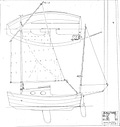
Boat Designs: Evaluating SCAMP’S Big Sister
(this new welsford cruiser checks a lot of boxes…).
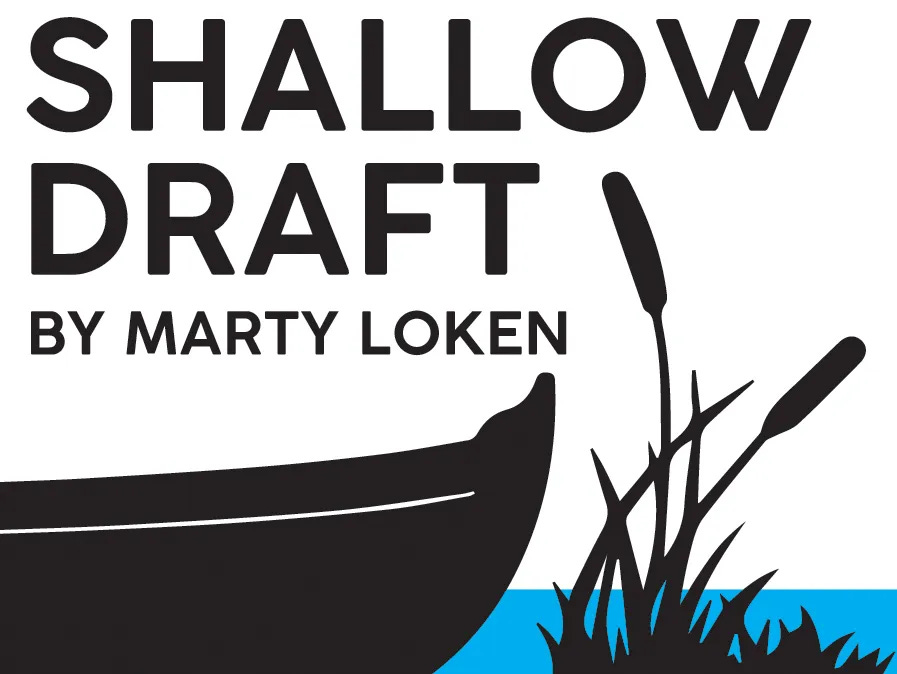
Over the past few days I’ve had email exchanges with John Welsford, New Zealand designer, regarding a brainstorm that’s been percolating in his clever, whimsical noggin: A bigger, more commodious takeoff on his wildly popular SCAMP design.
As most SCA readers know, the 11’ 11” SCAMP design was conceived 13 years ago when Josh Colvin, editor of this fine publication, asked Welsford to come up with a new kind of small cruising boat—one small enough to explore the most hard-to-penetrate backwaters, while being easy to rig, light enough to trailer with the smallest of tow vehicles, surprisingly great under sail, and comfy for overnight camp-cruising adventures. So, following some tweaks by designer and master boatbuilder Kees Prins, the resulting sailboat was dubbed SCAMP, for Small Craft Advisor Magazine Project.
SCAMP DRAWING…
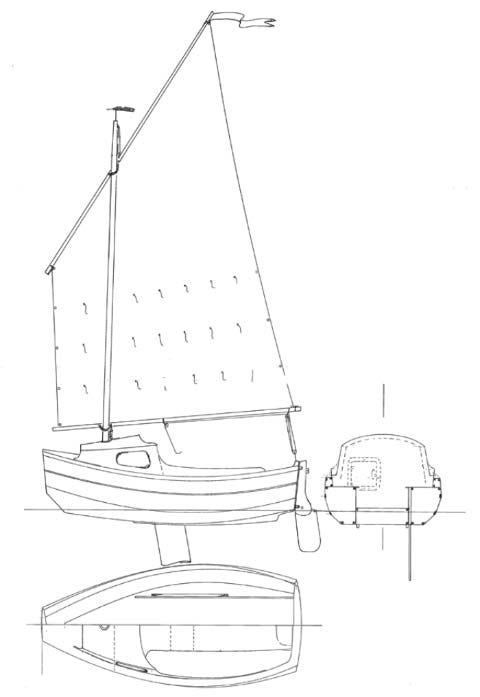
The rest is history: More building plans and kits for SCAMP have been sold over the years than any other small cruising boat we can think of. Besides the original wooden version, Gig Harbor Boat Works was licensed in 2013 to produce a fiberglass SCAMP, and the little giant killer—in wood and fiberglass—has since its debut been at the center of various small-boat rallies, workshops and sailing events.
While SCAMPs are still being built worldwide by enthusiasts, plan and kit sales have slowly been approaching what might be a kind of saturation point. It’s not that “everyone who wants a SCAMP has already built one,” but we get the feeling that it’s time for something new and different—like a SCAMP-inspired design that has the personality and quirky appeal of the original boat, but with more creature comforts (for an aging population of SCAMP lovers).
Meet SCALLYWAG, John Welsford’s big sister to SCAMP, a 15’ 4” x 7’ 3” wonder with a “real” cabin, tabernacle mast, mizzen sail, powerful main, water-ballast tanks, sitting headroom down below…and like SCAMP, faster than many onlookers might expect.
SCALLYWAG DRAWING…

This might turn out to be a timely, common-sense follow-up to the successful SCAMP design—so tempting that John Welsford is talking about building one for himself.
(As a footnote, we might add that in 2008, prior to the introduction of SCAMP in 2010, Welsford came up with another design that was similar to but somewhat larger than SCAMP—called TREAD LIGHTLY, which measured 13’ overall, with a beam of 5’ and addition of a mizzen. The series of similar hulls began with PEANUTS, an experimental build that never quite made the plans list. That design led to TENDER BEHIND, then SHERPA, then TREAD LIGHTLY, then SCAMP, then SCRAPS and now SCALLYWAG. Quite a series!)
TREAD LIGHTLY drawing…immediate predecessor to SCAMP)
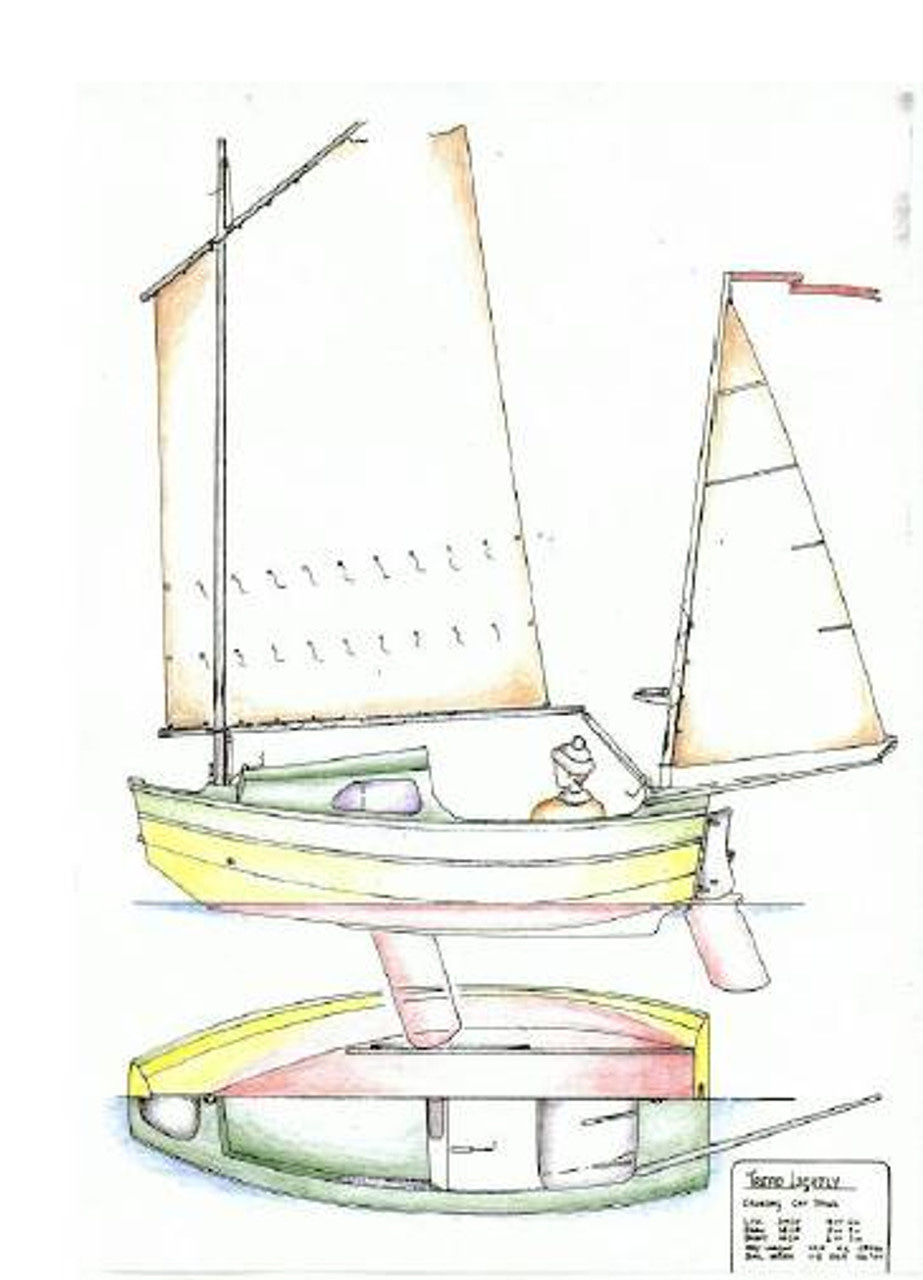
Here is John Welsford’s description of the SCALLYWAG design:
“I’ve had a number of people tell me they love SCAMP, but they’d like a ‘real’ cabin—something that would provide shelter for a couple of friends to overnight out of the rain; somewhere with space enough for four to sit and chat over coffee or rum on a cold evening; somewhere with a bench for a cooker, a table to eat the food off of, and lockers for all the essentials…and room for the skipper and first mate to stretch out and sleep in comfort.
“SCALLYWAG is not so big as to make launching and retrieving a chore; her mainmast is in a tabernacle, which makes standing it up easy-peasy for clients who don’t like the idea of lifting a mast that size vertically into place. Her mizzen is light enough to not be a worry, too, in that respect.
“The rig is a powerful one, but easy to access for reefing, and she will heave to under mizzen with the main let free so she sits mostly head-to-wind, dry and restful if a gust has to be waited out.
“I’ve added a pair of big water tanks for ballast, so with that and her beamy shape she’ll be very stable. Her cockpit self-drains, the motor is inside the tall transom for easy access, and while there’s room in the cockpit for four, she’ll be easy to single-hand and relaxing to sail.
“While the relationship between SCALLYWAG and SCAMP is obvious, it’s not just the styling. The backroom calculations in hydrodynamics suggest she’ll handle well, and be faster than many expect. With high stability and the ability to sit upright when aground, she’ll be able to transition from hiding in the mud or sand up a creek somewhere, to making a longer coastal passage without any fuss.
“Construction is simply plywood over ply bulkheads, with stringers to line everything up, and with considerable buoyancy just in case. The plans will have scale drawings of all major components, and we anticipate soon having printable full-sized templates for frames and other key items.”
As for specifications, beyond the overall length of 15’ 4” and beam of 7’ 3,” SCALLYWAG will have board-up draft of 10,” a board-down draft of 3’ 4,” a total sail area of 143 s.f. and a fully-rigged dry weight of 750 lbs. (Incidentally, the beam-to-length ratios of SCAMP and SCALLYWAG are almost identical.)
John Welsford says that plans for SCALLYWAG will be available on December 1, but he can take orders in the meantime. Price will be $245 U.S. funds for emailed, printable PDFs, and the plans can be ordered via John’s website: jwboatdesigns.co.nz (Joel Bergen, well-known for the Welsford Navigator he built and sails in many Northwest small-boat events, will be developing a set of SCALLYWAG patterns in the not-distant future, according to Welsford. Editor’s note: We heard from Joel yesterday; he’s hoping to develop CAD-produced patterns “in a few weeks,” now that he’s received initial SCALLYWAG drawings. Stay tuned; we’ll provide updates on plans and patterns in this space.)
FIRST IMPRESSIONS OF THE SCALLYWAG DESIGN:
Eager to hear what SCAMP-savvy friends might have to say about the SCALLYWAG specs and just-released drawing, we sought initial reactions from…
JOSH COLVIN, editor of Small Craft Advisor , who commissioned the SCAMP design in 2010 and enjoys sailing SCAMP #1:
“There’s certainly no doubt who designed this one! It looks almost as much like Welsford’s PENGUIN as a SCAMP. SCALLYWAG’s length is a sweet spot in terms of accommodations potential. She’ll be rowed less than most SCAMPs, but I love the inboard motor well to keep her lines clean, and the engine right at hand. But her most exciting feature is the addition of the mizzen, which will improve seaworthiness and make managing the mainsail easier.
“Between LONG STEPS and SCALLYWAG, those looking for something like SCAMP, but larger, have great options. I’m excited to see the first boat built—she will be bigger than most expect, just looking at the drawing.” SIMEON BALDWIN, builder of an early SCAMP who has perhaps sailed more nautical miles with a SCAMP than anyone…and who has also served as a generous advisor to fellow SCAMP builders and is an expert on rigging and sailing the little 11’ 11” boats:
“I like what I see of this long-rumored design. Knowing John and his attention to ergonomics, I can anticipate it will work well. The tabernacled mast and addition of a mizzen are most appealing.
“From the drawing I think it may resemble LONG STEPS in terms of the recessed footwell. It also appears he is eschewing a by-design lazarette made popular by many SCAMP owners.
“The double water tanks are something to contemplate. I don’t envision SCALLYWAG as a purpose-built racer with crew, actively keeping high-side ballast on long tacks, like the SKATE 15 that Brandon Davis designed, which utilizes two tanks and a dump-valve system that may be more elaborate than a typical cruising sailor would want to live with. But John may be describing two water tanks that are filled and remain separate from one another.”
(Editor’s note: Welsford’s comment on tanks, “The ballast tanks are linked, and they’re not far enough off the centerline to work independently. There is one each side of the aft end of the centerboard case and they go out as far as the seat-front extensions.”)
“I’m looking forward to how all of this works out!”
BRANDON DAVIS, of Turn Point Design in Port Townsend, whose company cuts CNC kits for the SCAMP and a variety of other small boats. Brandon is also a skilled designer and small-boat sailor:
“I really like this boat, since it has just enough room to have a cabin but it’s still small enough to be trailered, beached and easily built in a garage. The enclosed cabin should encourage longer trips or taking a friend along.
“The longer waterline should increase average sailing speeds. My guess is that rowing speed will be lower than the SCAMP, as the rower will not be able to take advantage of the waterline length because of her weight.
“Will SCALLYWAG be offered as a kit? I could see it selling well as a kit and the market could be ripe. Many SCAMP builders might consider this as their next build.
“I look forward to seeing the first SCALLYWAGs on the water!”
KEES PRINS, designer and boatbuilder, who constructed the first SCAMP while serving as boatshop manager at the Northwest Maritime Center…and in the process suggested and implemented some changes that improved the design:
“I think SCALLYWAG will find a great following in the SCAMP world and beyond. Adding a cabin will greatly enlarge the ‘SCAMP Crowd.’ At that beam, and with twin ballast tanks, stability should be enormous for a boat this length. I would have liked to see a cross section through the cabin to know more about sitting comfort. (Four people hanging out inside seems a little optimistic, but two should be comfortable.)
“I’m curious about what the tabernacle for the unsupported mast will look like. A big sail area, together with a stiff hull will induce a significant load on the tabernacle. There seems to be a deep well for the mast base to swing through, judging by the drain hole.
“All in all, SCALLYWAG looks very promising.”
OSCAR LIND, a serious student of all various small-boat designs , and earlier builder of a SCAMP, who shares at least one thing in common with John Welsford—they’ve never met a pun they didn’t like:
“I might have to clear out the shop and make as much room as possible to build this boat (due to the 7’ 3” beam, especially). It’s so tempting and fills the bill for usability and function.
“It does need a Chinese lug rig, though. I expect quite a few SCALLYWAGS will ultimately be built.”
(Editor’s note: John Welsford comments, “I like the Chinese lugsail, but for a sail of this size on a boat that will be trailered, rigged and derigged for each outing and dry-stored, the extra complexity of the Junk sail slows the process. As well, the balanced lug is in my experience, a little quicker upwind—unless the junk rig has cambered-panel sails, and there are few sailmakers producing those, so I think in this case, simplicity and performance get the nod.”)
As for my personal view as a serial boatbuilder, restorer and sometimes buyer of project boats, I enjoyed owning a SCAMP several years ago. While I loved sailing the boat, I wished it was bigger and included a sleeping cabin. So, John’s new SCALLYWAG design checks many more boxes as an all-around keeper, and I prefer its overall hull, cabin and rig design, not to mention its potential as a serious cruising machine.
So, once again, here’s a chance for you, as a fellow boat nut, to offer your evaluation of SCAMP and her newly-hatched big sister, SCALLYWAG. (Also, please add other thoughts in the comments section below…) • SCA •
Discussion about this post
| · Liked by Joshua Colvin, Marty Loken
|
| Liked by Marty Loken
|
Ready for more?

ALERT: WAREHOUSE CLOSURE SEPT 21-29. SHIPPING RESUMES SEPT 30th.
- Plans & Kits
- Plans by designer
- Paul Fisher
- Sailing Yachts
- Yachts 20' to 24'
24' Tasman Junk Rigged Yacht Plans
- Create New Wish List
Description
The Tasman is a multi-chine plywood yacht designed for long distance sailing for 2 crew, which uses an egg-box frame system of plywood fore and aft girders slotted together with plywood bulkheads - once stringers have been fitted, the ply hull panels are then applied making construction quite simple.
There are 2 steel bilge plates which are housed in the bunk fronts and the junk mast is hinged in a tabernacle for easy lowering. Steering etc is set up for control from inside the yacht although there is a cockpit and outboard well.
|
| ||
Related Products
24' strip planked motor yacht plans, 36' motor yacht plans, 4m mini yacht plans.

25' Songthrush Dutch Yacht Plans

Micro 8 - Mini Yacht Plans

- My Boats & Boat Articles
- Boatbuilding Plans
- Free Stitch and Glue Boat Plans

Steps in Building a SCAMP sailboat
Links to all my scamp building pages.
Link to Part 2 of Rigging
Rigging a scamp sailboat part1.
Part 1, Sail, Reefing, Downhaul, Outhaul
WARNING: The following article is a description of how I rigged my SCAMP. There is only incomplete information on the details of SCAMP rigging on the INTERNET and in the manual, and what I am presenting here is what I did. I'm not an expert. I've had my boat out a few times now and I have not found any great problem with the set up I'm using. I'm sure there are lots of improvements possible, but, this is working and seems to be safe. Take it as a place to start and improve what you find lacking. There are many right ways of rigging your SCAMP so be prepared for many arguments. This is offered as a good place to start. Maybe, just maybe, it's perfect and can't be improved on. (I wish!)
As I re-read this page I can see that it is confusing. It's a work in progress and I'll improve on it. I've been sick and have not had a lot of energy to improve my website.
There are many separate 'Systems' that add up to the completed rigging.
It's useful to think of the RIGGING as a collection of separate sub units. They affect each other of course but mostly function independently. This lists them in no particular order. I've included some topics that are not strictly rigging such as cleats, row locks and Safety. I'll include them in part 2.
- Positioning and Attaching the sail to the Boom and Yard
- Deck Fittings for Halyard and Downhaul
- Centre Board
- Cleats and Row Locks
Setting up the SAIL
The balanced lug sail, is four sided. that is attached to the boom fore and aft, and laced onto the yard. The yard is then attached to the halyard which raises it to the top of the mast, and the boom is attached to the downhaul which is attached to the cuddy roof at the bottom.
The downhaul is very important. It allows the sail to be tightened so that the leading edge, the part of the sail at the front, can be tightened to maintain proper shape of the sail.
Lacing the sail on
You need a bit of space to do this. Find yourself a nice lawn, or clean gym, or large living room. Lay your yard and boom down and spread out your sail in between.
Your yard will be thicker at one end than at the other. The thinner side goes towards the higher point of the sail, the PEAK in official sail talk. If your yard is much longer than your sail don't allow too much material at the lower end otherwise it will rub against the boom when you reef to the smallest area of sail.
You will need some line to lace your sail. Paracord works, or any reasonable line 3/16 - 1/4 inch. My sail came with a goodly supply.
Go ahead and tie your line to the throat grommet (the upper corner opposite the peak) and to the yard, this could be a few inches from the end. Link your knot to the hole you made in the yard so the sail doesn't slide along the yard.
I used a bowline on the grommet then used clove hitches and half hitches to attach the sail. You should now have one corner of the sail attached to the yard and to the hole. You can now lace the sail so that there is not a large gap between sail and yard but it is not pulled too tight.

In reality, the knots will likely look a bit messier than the diagrams but don't fret about that. When you reach the peak, tie your sail to the yard and through the hole on the yard. At this point the top of the sail should be secure to the yard and not able to slide one way or another. Leave yourself a bit of extra line so that if you decide to change your knots or lacing you have enough line. Once you are sure, then cut the lines and finish them either by melting or by binding the end.
There are a great many ways of lacing a sail onto spars. Mr. Google can come up with quite a list. There are arguments raging about the benefits of various variations. Don't fret, the simple lacing works very well. Below is my yard lacing. I did a slightly more attractive, to my eyes, lacing. There is quite a lot of extra length of my yard. I left as much as I could on the lower end to avoid putting more weight up high but the lower end was rubbing against the boom when the sail was reefed so I had to adjust. I also adjusted the slight fold you can see in the sail.

The boom is much simpler, the sail is not laced but only tied to the ends, the clew (under the peak above) and the tack. For the time being center the sail on the boom. If it needs to shift it's not hard to do as required.
The clew in the lower forward corner should be tied securely to the hole you have made in your boom using a strong piece of line. I used the same line I used to lace the sail but doubled it up. The tack is kept temporarily loose because it will be connected to an outhaul. The outhaul tensions the bottom of the sail and can be loosened or tightened as required to make the sail more or less flat. Until you have set up the outhaul, just tie the line to the boom through the back hole.
The sail is now attached to the yard on top and the boom below. You still have to sort out the outhaul.
Note that my holes on the ends of the boom are close to the ends. I should have left a bit more space between the end and the hole but because I misread the plans I ended up with a short boom that had to be re done. Because of Covid I had trouble getting suitable material so I used material I had, which ended up just a bit short. Hopefully your boom is longer than mine by a few inches.
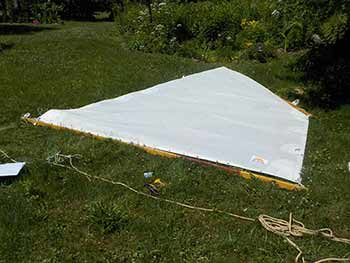
At this stage you should have a sail, laced on to the yard with the thinner end of the yard at the peak of the sail, and tied to the boom permanently at the fore end and temporarily at the aft end, waiting to have the outhaul installed.
I found it useful to label FORE AND AFT temporarily with tape. Saves having to figure it out every time.
Setting up the OUTHAUL
The purpose of the outhaul is to tighten or loosen the foot of the sail. It has to be convenient and easy. There are any number of ways this can be set up.

My outhaul consists of a short aluminium track screwed onto the top of the boom. There is a plastic slider that fits in the track. It is attached on the right to the corner of the sail,using a small shackle, and to the left on a line that goes to a small block lashed to the boom.
Disregard the fairlead and line in the first photo, this is part of the reefing system we will see later.
The block turns and guides the line around to a fairlead and a cam cleat bolted to the far side of the boom about 3-4 feet from the end so that the cam cleat would be at a convenient spot to reach in the cockpit. I have cut the ends of the bolts and sanded everything so it is smooth and does not catch or scratch.
I have a stop knot on the end of the outhaul line so it stays in the fairlead. The knot also makes it easier to pull the line. The line is 3/16 and is very strong. I bought 3 short length of a spectra blend, 2 for the rudder and one for the outhaul.
There is a stop at the end of the track to prevent the plastic slider from getting out of the track at the front.
The corner of the sail is loosely tied to the boom around the aluminium track. I'm not sure that is necessary but I wanted something to hold the sail in case the outhaul exploded. Or more likely, the plastic slider broke.
I bought the track from Duckworks but in hindsight it is overkill for my use. The corner of the sail could easily be tied to the line that goes to the block, bypassing the track. Looks boaty and high tech though!!
Some people add another block and gain some mechanical advantage so they don't have to pull hard. I will try it as it is and improve if necessary.
NOTE: After a few sails, the outhaul seems to work fine so I don't think I will change it.
Ok so now the outhaul is set up. In short, the sail is shackled to the plastic slider in the aluminium track. This slider is then tied to a strong line that goes through a small block lashed to the end of the boom and returns to a fairlead and a cleat on the reverse side of the boom.
You now have your sail attached to the spars with an outhaul nicely cleated tensioning the base of your sail.
Deck fittings for HALYARD AND DOWNHAUL
The halyard I put on starboard and the downhaul on the port side. There might be a traditional side for each but I did not worry about that.
When I made the roof of the cuddy I fitted a support across the edge of the roof. I had not yet figured out how I would use it but I knew there would be some lines to cleat and I wanted a slightly higher spot. I had also prepared some half inch plywood pieces to back the blocks near the mast.
The blocks on each side of the mast are simple to install, in theory, but in practice it was tricky to align the holes so that they would fit around the bulkhead and the mast step support. Everything is held together with stainless bolts, washers, and nuts. I used 3M 4200 so called "somewhat re-positionable" adhesive/sealant. In actual use it makes a very good adhesive.
The downhaul gets a sturdy cam cleat mounted on the edge support, while the halyard gets the same kind of cleat I used on the edges of the boat to attach the mooring lines.
Both of these cleats are bolted on the support on the edge of the cuddy.
After installing everything I realized that I had forgotten to insert the block in the base so I had to use a little shackle to connect the block to the metal based bolted to the roof.
I allowed the deck fittings to set before setting up the parts that connect to the sail and mast. The sealant/glue takes a day to set through and I didn't want to chance breaking the seal.

Now the deck hardware is installed for the halyard and the downhaul, deck blocks to turn the direction of the lines towards the back, and sturdy cleats.
Once I'm satisfied that the position of the hardware is working I will cut and sand the protruding bolts. It was difficult to get the right size hardware because of shipping difficulties and erratic stocks so I used longer bolts than needed.
Halyard and Downhaul can now be set up.
The last photo shows a test I did of the downhaul and halyard. I found that there is not much room to tighten the downhaul partly because My mast is a couple of inches shorter than designed. I can modify the setup and get a couple of more inches and this will work well. I was a bit doubtful of the big cleat for the halyard but I found that it works very well.
Setting up the HALYARD
The halyard attaches to the yard, goes up to a block at the top of the mast, then comes back down along the mast to the deck block alongside the mast, changes direction and goes on to the cleat at the edge of the cuddy roof.
When you pull on the line, the sail goes up. It's was a real thrill the first time I saw the sail go up.

I made 3 loops. One to attach a block at the top of the mast, one to connect the halyard to the yard, and a third to connect the downhaul to the boom. The boom and the yard loops have thimbles, it makes it sturdier to attach shackles. I did not put any on the one that connects the block because I had trouble getting them (covid and all.). Round thimbles would probably been better and shorter but this is what I could get. The loops just go around the spars and can easily be moved to adjust position. The top one, which attaches the block for the halyard, goes through the hole at the top of the mast. I knotted and secured the connections. I'll keep an eye on them as times goes on just to make sure they are not fraying or coming apart.
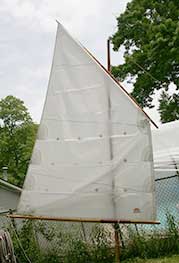
I fretted and worried about positioning the sail. This determines the position, fore or aft, of the sail and thus the balance of the rig. Ideally, which does not exist, the centre of effort is balanced against the center of resistance of the centerboard, hull, rudder, and I guess the skegs.
I placed the top connection about 2/5 of distance to the leading edge at the front. That is I divided the top of the sail in 5 and put my loop at the 2/5 spot. The photo is deceptive because of slight rotation and loose lines.
I placed the bottom connection so that the edge of the sail is the same distance from the mast top to bottom. This is not a requirement, just a place to start.
I sat in the grass with the mast in position and figure this out in the flat. (My boat was still in the winter shelter and I could not raise the sail properly, so after positioning the loops I tied the mast against a fence and raise the sail there.)
I've now been out 3 times in low wind and the sail position appears to be in the ball park. In the few stronger gusts, the boat kept going straight without needing correcting with the rudder. I'll adjust the position, forward or back when necessary.
So now, there is a loop supporting a block, attached to the mast at the top. This goes through the hole at the top of the mast. Because the sail rotates around the mast as the tack changes there needs to be about 6-8 inches of space between the yard and the hole in the mast. This allows the sail to move around.

OK, time to hoist the sail. You have a halyard, with one end tied to the cleat on the edge of the cuddy so it doesn't take off on you, and come out of the block at the top. This halyard goes through the deck block, goes up to the top of the mast through the block, then comes down. Hang on to this and don't let it get away to the top because you will have to lower the mast to re-thread it back through the block. Ask me how I know!! You are now hanging on to the end of the halyard.
Put this end through a swivel block and pull out about 18 or so inches. Make a knot at the 18 inch mark.
Tie another knot at the end on the curved part of a shackle. If you look at the picture I have, the line comes down through the swivel block, there is a knot, then there is another knot, DISREGARD THIS SECOND KNOT, I was just figuring out what to do and forgot to take it out before taking a photo.
I put a block with a swivel, but I don't think it is necessary. There exists fittings that are essentially 2 loops with a swivel in between, that would work just as well I think. Again I was hampered by the lack of access to fittings.
Now, you can take the shackle and fasten it through the thimble on the loop attached to the top spar, the yard, and through the end of the swivel end of the block. Close it tightly and you are ready to hoist the sail. Pull it up and cleat it.
Once the sail is up, you will see it will swing forward and the sail will be loose at the bottom, you need a downhaul.
This set up works but I think the lower block is not necessary and I could take it out entirely and only use the shackle directly in it's place. To be continued...
The line is 3/8 polyester.
SCAMP DOWNHAUL
The purpose of the downhaul is to pull down on the sail and tension the leading edge. Unlike other sails, the edge of the balanced lug sail is not set against the mast so it is free to flex unless pulled tight. In order to set properly, the edge must be under tension so it can shape properly.
The downhaul also positions the sail more or less forward or back depending on where you have located your loop. Your hardware should be in place already. That is, you have installed a deck swivel block that has a becket, you have a loop with a thimble hanging downwards, on the boom, you have a simgle block and a shackle ready.

Attach your single block to the the loop using the shackle. I'm using a stainless steel chain link instead of a shackle and I think it is working very well. It is easy to hang the link on both parts and it holds in place while the little captive nut is screwed on. You can see it at the very top of the detailed photo.
Tie your line to the deck block becket using a bowline knot. Pass the line through the single block and back down through the deck block and cleat it to the cam cleat you installed earlier.
You can now tighten the downhaul and it will pull the boom and sail down. The set up gives you a 2:1 mechanical advantage.
I expect I will eventually change the loop I have made with a round thimble instead of an oval one, and will get a shorter chain linker or shackle. This will enable me to pull the boom lower if necessary.
REEFING LINES
Reefing lines allow you to reduce sail easily while standing in the middle of the boat. No reaching and trying to balance holding on to a flopping sail. The down side of reefing lines is that there are yet another bunch of lines to get tangled.
They are simple to add and provide a lot of ease of mind.
If you look at your sail you will notice reef points along the fore and aft edges of the sail. Usually there are 3 but you might have only 2. I chose to only set up the smallest and largest reefing points. If I want to use the middle one I'll reef to the maximum and set up the other lines by hand then I can shake out the maximum reef. I did not set up the third reef because I felt the boom was getting a bit crowded and the chance of tangling was increasing.
These are simple to set up. You will need either smooth pad eyes, or fairleeds, some small cleats and 1/4 inch line. You will also need nuts and bolts to fasten through the boom. Choose 2 different colour lines otherwise you will get confused when reefing.
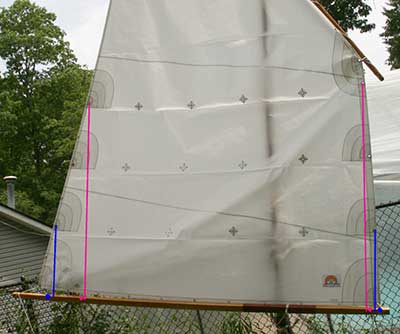
NOTE Don't leave too much yard or boom towards the front because when you reef the sail the spars might bump against each other, If you look at the photo you can see the yard protrudes beyond the sail and the boom rubbed against it. I had to move the sail further towards the right to fix this.
Lay out your sail in a nice patch of shade, or better raise your sail on the mast. Put a loose line in the reefing point you are setting up and mark where it falls on the boom. Mark the point then go back an inch or so. You want your reefing lines to be just a little bit wider than the width of the sail at the level of the holes so that when your reef is in the sail is not bunching up on the boom but rather are slightly under tension. You will not have the outhaul for the reefs. The fore of the sail is almost perpendicular so the points will be almost the same for each of the reefing points but the aft of the sail has more of a diagonal and the marks will be further apart. If you are on the grass make your best guess, it's not critical.

Position a pad eye or a fairleed in the 2 fore and aft spots you have chosen. Drill right through the side of the boom and install one on each side using nuts and bolts. Use the same bolt to fasten the pad eye on both sides. You will now have 8 pad eyes or fairleads, 4 aft and 4 fore. You can see 2 on the photo and if you look on the other side of the boom, there are 2 exactly the same bolted with the same nuts and bolts. Once you are happy with the positioning you can cut and sand the extra length of bolt.
Install one set fore and one set aft slightly higher so they don't interfere with each other's line, you can see that the one closer to the end is lower.
Some people install a pad eye on the back and a small block on the front.

You now need to bolt 4 small cleats towards the centre of the boom to tie off your reefing lines. I used black nylon cleats large enough to handle the 1/4 inch line.
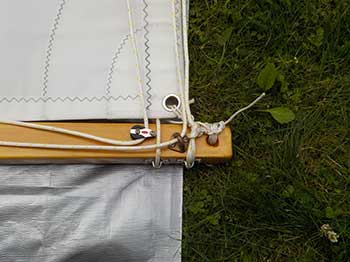
I wanted to use 2 nice cheek blocks that I had for the fore reefing setup but between the grass spot and my shop I lost one and could not find it even with the metal detector. So I used one and an extra pad eye I had from another boat build. There are pad eyes in the back same as on the other side.
To set up the reefing, tie a line to the back pad eye. Thread the line towards the front through the grommet in the sail at the level you want to reef, then down through the front pad eye. Don't tie the line in the front. Instead, run the line to one of the plastic cleats and tie it off. Make a knot about 8 inches away from the cleat. Any extra line can be cut and melted, when you have checked that the reef works to your satisfaction.
Do this fore and aft for the 2 or 3 reefs you are setting up.
To reef, lower the sail the amount you will be shortening the sail, then uncleat the reef line you want on one side, and simply pull on it.
The line will tighten and start pulling the boom upwards towards the reef. When the boom and the reef grommet are near each other cleat your reef line and do the same to the other end of the sail.
Tighten the downhaul till the sail is deployed. You might have to loosen or tighten the halyard.
Your sail will have little holes along the middle between the reefing points. You can put short lines through these grommets and use them to tie up the middle section of the sail along the boom. Tie only the sail, not the sail with the boom.
It's not essential to have reefing ties but it makes things tidier looking.
Part 2 of this page which describes the Lazy jacks, Mainsheet and traveler and centreboard set up.
emails: Christine
If you decide to build a boat be careful. These tools can be dangerous. If you don't know how to safely handle something find out.
This web site reflects my personal ideas and doesn't represent anyone else's point of view. I don't claim to be an expert in anything, just someone muddling along.
I pay for maintaining this website by having links to Amazon.com. I choose the ads to be relevant to the content. Mostly stuff that I buy myself or lust after. If you buy after clicking one of the links I get a small fee.


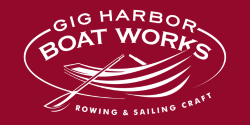
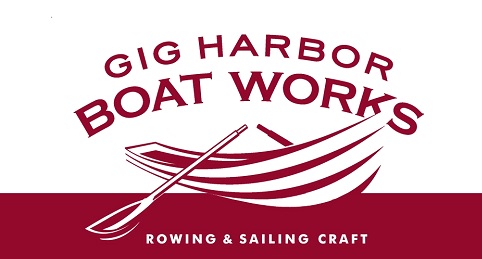
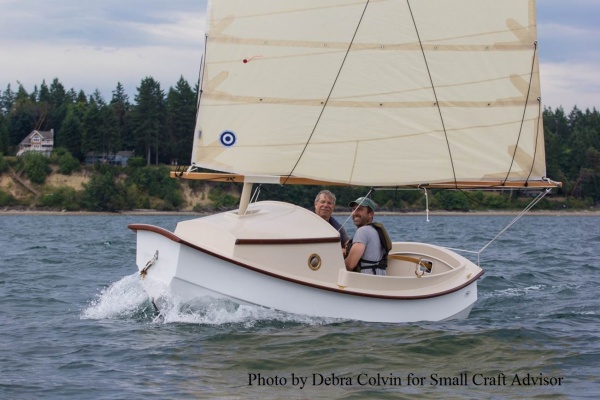
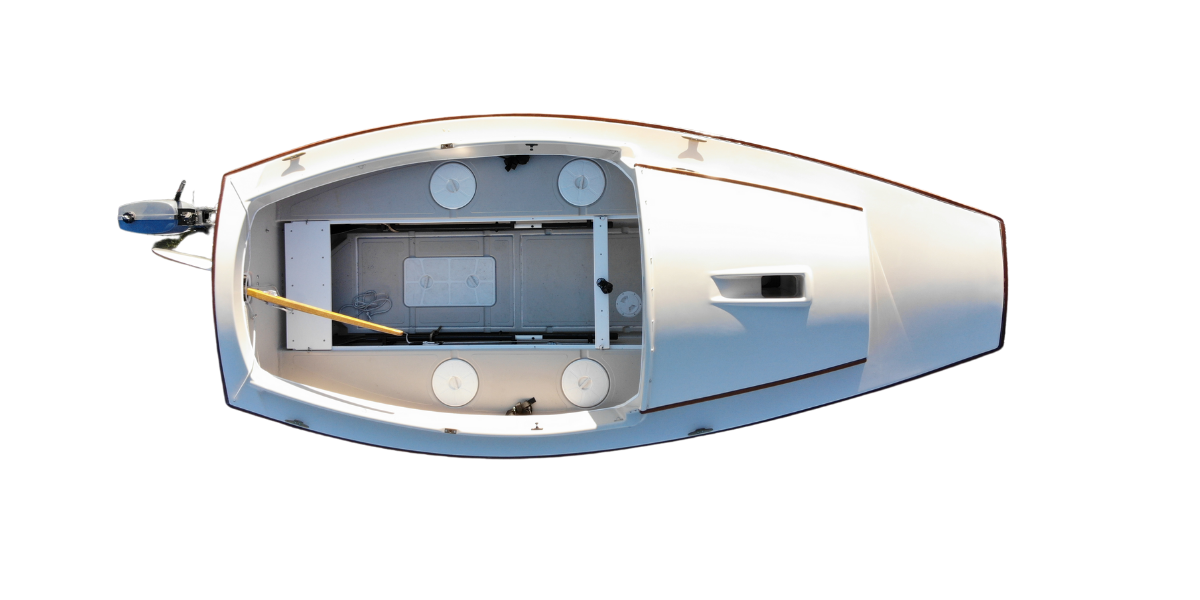

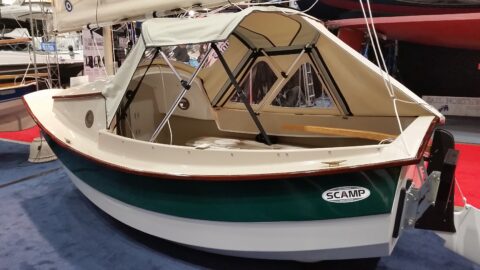


IMAGES
VIDEO
COMMENTS
As most SCA readers know, the 11' 11" SCAMP design was conceived 13 years ago when Josh Colvin, editor of this fine publication, asked Welsford to come up with a new kind of small cruising boat—one small enough to explore the most hard-to-penetrate backwaters, while being easy to rig, light enough to trailer with the smallest of tow ...
Josh Colvin, who commissioned SCAMP—an acronym for Small Craft Advisor Magazine Project—wasn't looking for an ultimate adventure boat when he approached New Zealand designer John Welsford (see WB No. 225 for a profile on Welsford and his design work). "My initial goals for the boat were based largely on a 150-mile sail down the Columbia ...
The JRA (Junk Rig Association), formed in 1980, aims to further the development of the junk rig and to create an international community of people interested in such rigs to share experience and ideas.
SKU: SEL-24TASMAN. Availability: Printed plans shipped and PDF plans emailed from Selway Fisher. $34.00 - $540.00. Type of plans: Required Full Plans Study Plans. Plan format: Required PDF (to be emailed) Printed (sent by post) Quantity: Decrease Quantity of 24' Tasman Junk Rigged Yacht Plans.
A full tutorial on rigging Gig Harbor Boat Works balanced-lug Scamp sailboat.Learn more about the Scamp at https://ghboats.com/12-scamp/
Tie your line to the deck block becket using a bowline knot. Pass the line through the single block and back down through the deck block and cleat it to the cam cleat you installed earlier. You can now tighten the downhaul and it will pull the boom and sail down. The set up gives you a 2:1 mechanical advantage.
Installing the bow eye. Making the portholes/deadlights. Oar Socket Placement. Making the SCAMP mast. Turning SCAMP over. Sanding, marking waterline and Painting outside of hull. Finishing shaping the Bottom. Making the centreboard. Centreboard pivot and details.
See You at Anacortes Boat & Yacht Show, May 16-18! Contact Us. Phone: (253) 851-2126. Click here to send us an e-mail. Showroom Address: 9905 Peacock Hill Ave. Gig Harbor, WA 98332. Open Monday-Friday 9 am - 5 pm (Pacific time) Saturdays by appointment only.
Exciting news that's been a long time coming . . . the Small Craft Advisor magazine released their first formal review of the SCAMP! For a bit of backstory, the SCAMP, which stands for Small Craft Advisor Magazine Project, was originally conceived by the magazine as a kit boat that would meet the needs of adventurous small craft sailors.It was designed by a team of passionate and ...
Rigging the SCAMP Yard. First, I unpacked my Neil Pryde Tanbark SCAMP Sail and laid the spars in position to get an overall look at the rig. Then I lashed on the peak of the sail to the top of the yard. Next I laced the top edge of the sail to the yard, with one long rope. Then I lashed the throat cringle to the yard end, being sure to lash to ...
SCAMP has plenty of freeboard, lots of dry stowage, a self draining cockpit-and for safety's sake a huge amount of air-tank buoyancy. ... small boat that would otherwise be bounced around by the waves and powerboat wakes in a big boat anchorage. The rig is a simple balanced lugsail. I'd expect the boat to be ready to launch within 15 minutes of ...
The JRA (Junk Rig Association), formed in 1980, aims to further the development of the junk rig and to create an international community of people interested in such rigs to share experience and ideas.
Jason died when later in life he was sleeping under the Argo and it fell on him. Specifications of the SCAMP that I built: Rig: Balanced Lug Rig (Lugger) LOA: 11 ft 11 in (3.63 m) Beam: 5 ft 4 in (1.63 m) Draft: 7 in (180 mm) with centerboard and rudder up. Hull weight: 420 lb (190 kg) (including rig)
SCAMP is an eminently capable micro-cruiser commissioned by Small Craft Advisor magazine, designed by John Welsford. Only 12 feet long, yet the feel of a larger boat. High freeboard, hard chines and full ends give lots of buoyancy and carrying capacity. 178 pounds of water ballast. Flat bottom with keelsons tracks surprisingly well and sits ...
Cost: Tuition for the ten day virtual Camp is $875.00 (A $1,000 savings over in person SCAMP Camp's) The Kit: Contact Small Craft Advisor/Duckworks to order your kit, which will then be shipped to the build location of you're choice. WWW.DUCKWORKS.COM. 2024 SCALLYWAG CAMP. June 24th- July 5th, 2024.
It takes into consideration "reported" sail area, displacement and length at waterline. The higher the number the faster speed prediction for the boat. A cat with a number 0.6 is likely to sail 6kts in 10kts wind, a cat with a number of 0.7 is likely to sail at 7kts in 10kts wind. KSP = (Lwl*SA÷D)^0.5*0.5
Business, Economics, and Finance. GameStop Moderna Pfizer Johnson & Johnson AstraZeneca Walgreens Best Buy Novavax SpaceX Tesla. Crypto
14. Visit the Old Water Tower. Source: Photo by Wikimedia Commons user Dom kobb used under CC BY-SA 3.0. The old water tower is one of Yekaterinburg's oldest structures dating back to the 1800s and stands as a monument of industrial architecture. It is one of the city's endearing symbols.
The Scamp is a seaworthy 12′ sailboat that can handle a good dose of adventure. Just under 12 feet in length, Scamp boasts an unusual combination of features that give her the unique ability to explore waters too shallow for a larger boat, while retaining most of the bigger boat's comforts and capabilities. An offset centerboard opens up ...
For sale - Cod. 29133. Tipology: 1 Bedroom Area: 43 m² Rooms No.: 1 Floor: 13 Publication date announcement: 26/08/2016 Hello, we are the owners, Irina and Oleg. We sell a bright, comfortable and very beautiful flat, designed in a Scandinavian style.
SVERDLOVSK OBLAST. Sverdlovsk Oblast is the largest region in the Urals; it lies in the foothills of mountains and contains a monument indicating the border between Europe and Asia.
The JRA (Junk Rig Association), formed in 1980, aims to further the development of the junk rig and to create an international community of people interested in such rigs to share experience and ideas.